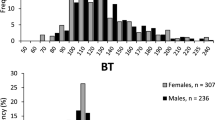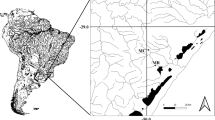Abstract
Catfish have been used as a model system for studying biochemical mechanisms of biotransformation. The main goal of this study was to identify alterations in hepatic glutathione S-transferase (GST) activity and changes in the parental care pattern of a mouth-brooding catfish, Sciades herzbergii, as a biomarker of anthropogenic impact in a port area on the northeastern coast of Brazil. The fish were sampled from a natural reserve (A1 = reference site) and from an industrialized port area (A2 = impacted site). Two analyses were carried out: hepatic GST activity and mouth-brooding behavior of males. Catfish collected from the A1 site displayed all stages of gonadal maturation, and some of the adult males were mouth brooding 12–30 embryos. Not all gonadal maturation stages of the catfish were represented at the A2 site, and no mouth-brooding males were observed. GST activity in the liver of S. herzbergii was significantly higher in fish from the impacted site compared with fish from the reference site. Values for the enzymatic activity increased progressively in fish sampled from the reserve area as they became more reproductively mature (immature ≤ maturing ≤ mature ≤ spent). However, the greatest values for GST activity (2.84 ± 0.31 μmol min−1 mg protein−1) among fish sampled from the impacted area were found in (immature) juveniles. These data suggest that changes in hepatic GST activity and mouth-brooding behavior of S. herzbergii can be used as biomarkers of anthropogenic impact.


Similar content being viewed by others
References
Abollino O, Aceto M, Saccchero G, Sarzanini C, Mentasti E (1995) Determination of copper, cadmium, iron, manganese, nickel and zinc in Antarctic sea water. Comparison of electrochemical and spectroscopic procedures. Analyt Chim Acta 305:200–206
Adams SM (1990) Biological indicators of stress in fish. Am Fish Soc Symp 8:190–195
Antaq (2015) Agência Nacional de Transportes Aquaviários. Principais portos do Brasil. http://www.antaq.gov.br. Accessed 20 Jan 2015
Azevedo MCC (1999) Variação espacial e temporal de bagres marinhos (Siluriformes, Ariidae) na Baía de Sepetiba, Rio de Janeiro. Rev Bras Biol 59:443–454
Barbieri GM (1992) Biologia de Astyanax scabripinnis paranae (Characiformes, Characidade) do ribeirão do Fazzari. São Carlos. Estado de São Paulo. II. Aspectos quantitativos da reprodução. Rev Bras Biol 52:589–596
Bila DM, Dezotti M (2007) Desreguladores endócrinos no meio ambiente: efeitos e consequências. Quím Nova 30:651–656
Canli M, Atli G (2003) The relationships between heavy metal (Cd, Cr, Cu, Fe, Pb, Zn) levels and the size of six Mediterranean fish species. Environ Pollut 121:129–136
Cantanhêde G, Castro ACL, Gubiani EA (2007) Biologia reprodutiva de Hexanematichthys proops (Siluriformes, Ariidae) no litoral ocidental maranhense. Iheringia, Sér Zool 97:498–504
Carvalho-Neta RNF, Abreu-Silva AL (2010) Sciades herzbergii oxidative stress biomarkers: an in situ study of estuarine ecosystem (São Marcos Bay, Maranhão, Brazil). Braz J Oceanogr 58:11–17
Carvalho-Neta RNF, Abreu-Silva AL (2013) Glutathione S-Transferase as biomarker in Sciades herzbergii (Siluriformes: Ariidae) for environmental monitoring: the case study of São Marcos Bay, Maranhão, Brazil. Braz Lat Am J Aquat Res 41:217–225
Carvalho-Neta RNF, Castro ACL (2008) Diversidade das assembléias de peixes estuarinos da Ilha dos Caranguejos, Maranhão. Arq Ciên Mar 41:48–57
Carvalho-Neta RNF, Torres ARJ, Abreu-Silva AL (2012) Biomarkers in catfish Sciades herzbergii (Teleostei: Ariidae) from polluted and non-polluted areas (São Marcos’ Bay, Northeastern Brazil). Appl Biochem Biotechnol 166:1314–1327
Carvalho-Neta RNF, Torres ARJ, Silva D, Cortez CM (2014) A simple mathematical model based on biomarkers in stress-resistant catfish species, Sciades herzbergii (Pisces, ariidae), in São Marcos Bay, Brazil. Appl Biochem Biotechnol 174:2380–2391
Conama (2005) Resolucão número 357. Diário Oficial da República Federativa do Brasil. http://www.mma.gov.br/port/conama/res/ res05/res35705.pdf. Accessed 21 Aug 2013
Conama (2011) Resolução número 430. Diário Oficial da República Federativa do Brasil. http://www.mma.gov.br/port/conama/ legiabre.cfm?codlegi = 646. Accessed 18 March 2015
Das B, Khan YSA, Das P, Shaheen SM (2002) Organochlorine pesticide residues in catfish, Tachysurus thalassinus (Ruppell, 1835), from the south patches of the bay of bengal. Environ Pollut 120:255–259
Dietrich GJ, Dietrich M, Kowalski RK, Dobosz S, Karol H, Demianowicz W, Glogowski J (2010) Exposure of rainbow trout milt to mercury and cadmium alters sperm motility parameters and reproductive success. Aquat Toxicol 97:277–284
EMAP (2015) Empresa Maranhense de Administração Portuária. http//www.emap.ma.gov.br. Accessed 21 Aug 2015
Fávaro LF, Frehse FDA, Oliveira RND, Schwarz R (2005) Reproduction of the Madamango sea catfish, Cathorops spixii (Agassiz) (Siluriformes, Ariidae), of the Pinheiros Bay, estuarine coastal area of Paraná, Brazil. Rev Bras Zool 22:1022–1029
Fossi MC, Casini S, Marsili L, Mori G, Néri G, Romeo T, Ausili A (2004) Evaluation of the Mediterranean population of swordfish (Xiphias gladius). Mar Environ Res 48:425–429
Gagnon MM, Rawson CA (2016) Integrating multiple biomarkers of fish health: a case study of fish health in ports. Arch Environ Contam Toxicol 70:192–203
Galkus A, Joksas K, Stakeniene R, Lagunaviciene L (2010) Heavy metal contamination in harbor bottom sediments. Pol J Environ Stud 21:1583–1594
Garcia DAZ, Casimiro ACR, Orsi ML (2012) Introduction of the armored catfish, Pterygoplichthys ambrosettii (Holmberg, 1893) in a large effluent of the Upper Parana River basin. J Appl Ichthyol 28:138–139
Gomes ID, Araújo EG, Azevedo MCC, Pessanha ALM (1999) Biologia reprodutiva dos bagres marinhos Genidens genidens (Valencianes) e Cathorops spixii (Agassiz) (Siluriformes, Ariidae) na Baía de Sepetiba, Rio de Janeiro, Brasil. Rev Bras Zool 16:171–180
Habig WH, Pabst MJ, Jacoby WB (1974) Glutathione-S-transferases. The first enzymatic step in mercapturic acid formation. J Biol Chem 249:7130–7139
Hammerschidt CR, Sandheinrich MB, Wiener JG, Rada RG (2002) Effects or dietary MeHg on reproduction of fathead minnows. Environ Sci Technol 36:877–883
Harzer B, Stipp MC, Herrerias T (2015) Avaliação da função hepática de peixes Rhamdia quelen expostos aos desreguladores endócrinos estriol e estrona. Revinter 8:82–85
Hilbig CC, Bombardelli RA, Sanches EA (2008) Efeito do chumbo sobre a fertilizacão artificial e incubação de ovos de jundiá cinza (Rhamdia quelen). Acta Sci Anim Sci 30:217–224
IBGE (2015) Instituto Brasileiro de Geografia e Estatística. http://www.ibge.gov.br/estadosat/perfil.php?sigla=ma#. Accessed 24 Sept 2015
Kasper D, Botaro D, Palermo EFA, Malm O (2007) Mercúrio em peixes-fontes e contaminação. Oecol Bras 11:228–239
Kehrig HA, Malm O, Palermo EF, Seixas TG, Baêta AP, Moreira I (2011) Bioconcentração e biomagnificação de metilmercúrio na baía de Guanabara. Quim Nova 34:377–384
Kime DE (1995) The effects of pollution on reproduction in fish. Rev Fish Biol 5:52–96
Kime DE (2000) A strategy for assessing the effects of xenobiotics on fish reproduction. Kluwer Academy Publishers, New York
Lacaze JC (2000) Poluição dos mares. Porto editora, São Paulo
Latif MA, Bodaly RA, Johnston TA, Fudge RJP (2001) Effects of environmental and maternally derived methylmercury on the embryonic and larval stages of walley (Stizostedion vitrem). Environ Pollut 111:139–148
Leblond V, Hontela A (1999) Effects of in vitro exposures to cadmium, mercury, zinc, and 1-(2-Chlorophenyl)-1-(4-chlorophenyl)-2,2-dichlroethane on steroidogenesis by disposed interrenal cells of rainbow trout (Oncorhynchus mykiss). Toxicol Appl Pharm 157:16–22
Lepland A, Andersen TJ, Lepland A, Arp HPH, Alve E, Breedvly G, Rindby A (2012) Sedimentation and chronology of heavy metal pollution in Oslo Harbor, Norway. Mar Pollut Bull 60:1512–1522
Lins JAPN, Kirschnik PG, Queiroz VS, Cirio SM (2010) Uso de peixes como biomarcadores para monitoramento ambiental aquático. Rev Acad Agrár Ambient 8:469–484
Manzetti S, van der Spoel ER, van der Spoel D (2014) Chemical properties, environmental fate, and degradation of seven classes of pollutants. Chem Res Toxicol 27:713–737
Marimuthu K, Cheen AC, Muralikrishnan S, Kumar D (2010) Effect of different feeding frequency on the growth and survival of African catfish (Clarias gariepinus) fingerlings. Adv Environ Biol 4:187–193
Martín-Díaz ML, Blasco J, Sales D, DelValls TA (2008) Field validation of a battery of biomarkers to assess sediment quality in Spanish ports. Environ Pollut 151:631–640
Martins-Juras IAG (1989) Ictiofauna estuarina da ilha do Maranhão (MA -BRASIL). Tese (Doutorado), Instituto Oceanográfico, USP, São Paulo
Oliveira MA, Novelli R (2005) Idade e crescimento do bagre Genidens genidens na Baía da Lagoa do Açu, norte do Estado do Rio de Janeiro. Trop Oceanogr 33:57–66
Oruc EO, Sevgiler Y, Uner N (2004) Tissue-specific oxidative stress responses in fish exposed to 2,4-D and azinphosmethyl. Comp Biochem Physiol 137:43–51
Penha JMF, Mateus LAF, Barbieri G (2004) Age and growth of the porthole shovelnose catfish (Hemisorubim platyrhynchos) in the Pantanal. Braz J Biol 64:833–840
Pinheiro-Sousa DB, Almeida ZS, Carvalho-Net RNF (2013) Integrated analysis of two biomarkers in Sciades herzbergii (Ariidae, Siluriformes), to assess the environmental impact at São Marcos’ Bay, Maranhão, Brazil/Análisis integrado de dos biomarcadores en Sciades herzbergii (Ariidae, Siluriformes) para evaluar el impacto ambiental en la Bahía de San Marcos, Maranhão, Brasil. Lat Am J Aquat Res 41:305–312
Powers DA (1989) Fish as model systems. Science 246:352–358
Rand GM, Petrocelli SR (1985) Fundamentals of aquatic toxicology: methods and applications. Hemisphere Publish, Washington
Reis EG (1986) Reproduction and feeding habits of the marine catfish Netuma barba (Siluriformes, Ariidae) in the estuary of Lagoa dos Patos, Brazil. Atlântica 8:35–55
Romagosa E (2010) Reproductive status in females of the Brazilian catfish, Pseudoplatystoma fasciatum reared in cages. J Appl Ichthyol 26:806–811
Roy S, Bhattacharya S (2006) Arsenic-induced histopathology and synthesis of stress proteins in liver and kidney of Channa punctatus. Ecotox Environ Safe 65:218–229
Sousa JKC (2009) Avaliação de impactos ambientais causados por metais traço em água, sedimento e material biológico na Baia de São Marcos, São Luís—Maranhão. Dissertation, Universidade Federal da Paraíba, João Pessoa, Brasil
Triebskorn R, Köhler HR, Honnen W, Schramm M, Adams SM, Müller EF (1997) Induction of heat shock proteins, changes in liver ultrastructure, and alterations of fish behavior: are these biomarkers related and are they useful to reflect the state of pollution in the field? J Aquat Ecosyst Stress Recovery 6:57–73
Van der Oost R, Beyer J, Vermeulen NP (2003) Fish bioaccumulation and biomarkers in environmental risk assessment: a review. Environ Toxicol Pharmacol 13:57–149
Vazzoler AEM (1996) Biologia e reproducão de peixes teleósteos: teoria e prática. Eduem Press, Maringá
WHO (1990) Enviromental Health Criteria (EHC 101). Methylmercury. WHO, Geneva
Wierner JG, Spry DJ (1996) Toxicological significance of mercury in fresh water fish. In: Beyer B (ed) Environmental contaminants. Lewis Publishers, Boca Raton, pp 297–339
Wierner JG, Krabbenhoft DP, Heinz GH, Scheuhammer AM (2003) Ecotoxicology of mercury. In: Hoffman DJ, Burton BAGA (eds) Handbook of ecotoxicology. CRC Press, Boca Raton, pp 1311–1312
Winkaler EU, das Graças Silva A, Galindo HC, dos Reis Martinez CB (2008) Biomarcadores histológicos e fisiológicos para o monitoramento da saúde de peixes de ribeirões de Londrina, Estado do Paraná. Acta Sci Biol Sci 23:507–514
Winston GW, Di Giulio RT (1991) Prooxidant and antioxidant mechanisms in aquatic organisms. Aquat Toxicol 19:137–161
Witt G, Lang SC, Ullmann D, Schaffrath G, Schulz-Bull D, Mayer P (2013) Passive equilibrium sampler for in situ measurements of freely dissolved concentrations of hydrophobic organic chemicals in sediments. Environ Sci Technol 47:7830–7839
Acknowledgements
The authors thank the staff of the Laboratory of Biomarkers in Aquatic Organisms (Biomarcadores em Organismos Aquáticos: LABOAq) at the Universidade Estadual do Maranhão (UEMA), Brazil, and the Maranhão State Research Foundation (Fundação de Amparo à Pesquisa e ao Desenvolvimento Científico e Tecnológico do Maranhão: FAPEMA) for financial support.
Author information
Authors and Affiliations
Corresponding author
Ethics declarations
Conflicts of interest
The authors declare that they have no conflict of interest.
Rights and permissions
About this article
Cite this article
Fortes Carvalho Neta, R.N., Barbosa, G.L., Torres, H.S. et al. Changes in Glutathione S-Transferase Activity and Parental Care Patterns in a Catfish (Pisces, Ariidae) as a Biomarker of Anthropogenic Impact in a Brazilian Harbor. Arch Environ Contam Toxicol 72, 132–141 (2017). https://doi.org/10.1007/s00244-016-0326-0
Received:
Accepted:
Published:
Issue Date:
DOI: https://doi.org/10.1007/s00244-016-0326-0




